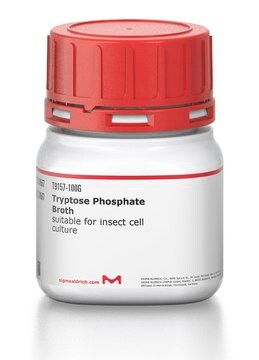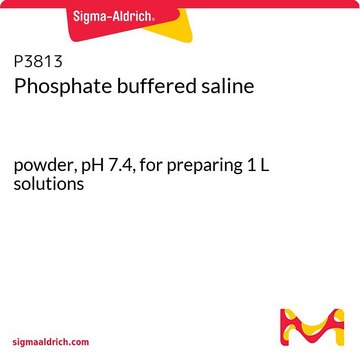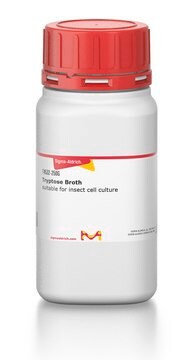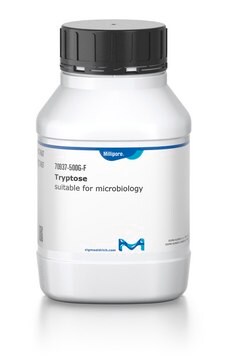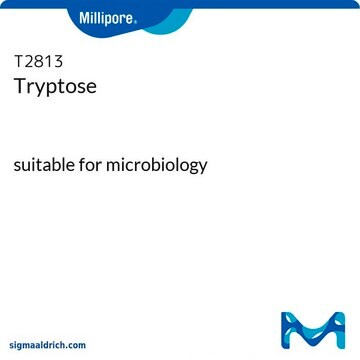T8782
Tryptose Phosphate Broth
buffered powder, Microbiologically tested.
Sinónimos:
Tryptose Broth
Iniciar sesiónpara Ver la Fijación de precios por contrato y de la organización
About This Item
UNSPSC Code:
41106507
NACRES:
NA.75
Productos recomendados
form
buffered powder
quality
Microbiologically tested.
General description
The tryptose component of Tryptose Phosphate Broth is a peptone (mixture of amino acids and short peptides) derived by the mixed enzymatic hydrolysis (pancreatic enzymes) of the milk protein casein.
Application
In addition to its use for the growth of fastidious micro-organisms, Tryptose Phospate Broth (TPB) has been studied as supplement for the preparation of media that supports vaccine production in BHK-21 cells and the growth of SF21 insect cells in high-density perfusion culture stirred-tank bioreactors.
Tryptose Phosphate Broth has been used as a component:
- of Leibovitz L-15 medium for the culture of BME26 tick embryo cell line
- of M199 medium for the preparation of chick embryo fibroblasts (CEFs)
- of Glasgow′s minimum essential medium (GMEM) for culturing baby hamster kidney (BHK-21) before transfection
Biochem/physiol Actions
Tryptose Phosphate Broth provides a source of amino acid based nutrients and survival factors that support the growth of fastidious micro-organisms such as Brucella, Streptococcus, and Neisseria; as well as eukaryotic cells such as insect and animal cells. Dextrose provides a fermentable carbohydrate that can be used by fastidious micro-organisms. Sodium chloride maintains the osmotic and ionic equilibrium and disodium phosphate provides the basic buffering capacity.
Components
Tryptose Phosphate Broth (TPB) is composed of four components: Tryptose (20g/L); Dextrose (2g/L); NaCl (5g/L) and Disodium Phosphate (2.5g/L) typically adjusted to pH 7.3. The tryptose component is a peptone (mixture of amino acids and short peptides) derived by the mixed enzymatic hydrolysis (pancreatic enzymes) of the milk protein casein. This hydrolysate provides a source of amino acid based nutrients and survival factors that support the growth of fastidious micro-organisms such as Brucella, Streptococcus, and Neisseria; as well as eukaryotic cells such as insect and animal cells. Dextrose provides a fermentable carbohydrate that can be used by fastidious mico-organisms. Sodium chloride maintains the osmotic and ionic equilibrium and disodium phosphate provides the basic buffering capacity.
Comparable product
also commonly purchased with this product
Referencia del producto
Descripción
Precios
Storage Class
11 - Combustible Solids
wgk_germany
WGK 1
flash_point_f
Not applicable
flash_point_c
Not applicable
ppe
Eyeshields, Gloves, type N95 (US)
Elija entre una de las versiones más recientes:
¿Ya tiene este producto?
Encuentre la documentación para los productos que ha comprado recientemente en la Biblioteca de documentos.
Los clientes también vieron
The use of sonicated lipid vesicles for mass spectrometry of membrane protein complexes
Chorev DS, et al.
Nature Protocols, 15(5), 1690-1706 (2020)
Dror S Chorev et al.
Nature protocols, 15(5), 1690-1706 (2020-04-03)
Recent applications of mass spectrometry (MS) to study membrane protein complexes are yielding valuable insights into the binding of lipids and their structural and functional roles. To date, most native MS experiments with membrane proteins are based on detergent solubilization.
S N Saha et al.
Vaccine, 7(4), 357-363 (1989-08-01)
Studies were undertaken to develop a cheaper medium with indigenous sources of peptone and casein hydrolysate for continuous culture of BHK-21 (suspension) cells and production of foot-and-mouth disease (FMD) vaccine. Eleven batches of experimental media were prepared using different indigenous
A I Josemans et al.
Annals of the New York Academy of Sciences, 969, 141-146 (2002-10-17)
The in vitro culture of Cowdria ruminantium, the causative agent of heartwater in domestic ruminants, was first achieved in 1985. Culture media were usually supplemented with serum and tryptose phosphate broth, both undefined components, contributing to great variability. Recently, we
S M Deutschmann et al.
Enzyme and microbial technology, 16(6), 506-512 (1994-06-01)
Spodoptera frugiperda insect cells (IPLB-Sf21-AE) (Sf21), infected with baculovirus expression vectors during their exponential growth phase, are commonly used to produce a variety of heterologous recombinant proteins. In the present study the culture conditions of these insect cells were studied
Artículos
Detect mycoplasma contamination in cell cultures three ways: culture test, DNA stain test, or mycoplasma PCR test. Mycoplasma elimination kits rid cultures of contamination.
Nuestro equipo de científicos tiene experiencia en todas las áreas de investigación: Ciencias de la vida, Ciencia de los materiales, Síntesis química, Cromatografía, Analítica y muchas otras.
Póngase en contacto con el Servicio técnico
